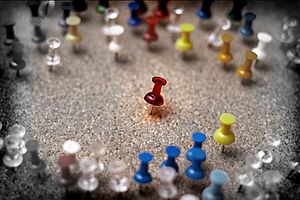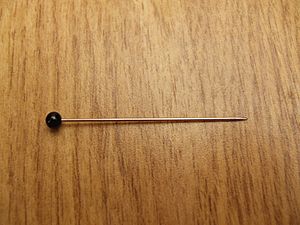Pin facts for kids

A pin is a small, thin object used to hold things together. Pins can be made from different materials like steel, copper, brass, wood, or plastic.
There are many kinds of pins. Some pins are like a straight stick with a sharp point. These are used to poke through soft materials like fabric or paper. Think of a sewing pin or a push pin.
Other pins are made of a flexible material, like a wire. They are bent into a shape that can hold things tightly. A bobby pin is a good example of this type.
Contents
Pins for Sewing and Fashion
People have used pins for a very long time. Archeologists have found curved sewing pins that are over four thousand years old! The first pins were made from iron and bone by the Sumerians. They used them to hold clothes together. Later, pins were even used to hold pages of books together.
Many pins were later made from brass. Brass is a strong metal that became available during the Bronze Age. After brass, people started using steel. Steel was even stronger, but it could rust if it got wet.
To stop steel pins from rusting, people started covering them with other metals. They used a process called electroplating to cover the steel with nickel. Nickel didn't rust, but sometimes it would flake off. Even so, nickel-plated steel pins worked well enough for holding fabric temporarily. Today, some special pins are made from very strong, rust-proof titanium.
In the 18th century, Adam Smith wrote about how pins were made. He showed how many different steps were involved. In 1832, John Ireland Howe invented a machine to make pins. His company could make 72,000 pins every day!
Walter Hunt invented the safety pin. He bent an eight-inch brass pin into a special shape with a spring and a guard. He sold the rights to his invention to pay a debt. He didn't know then that his invention would be worth millions of dollars!
Different Kinds of Straight Pins
Straight pins are very common, especially for sewing. They have a sharp point and a head. Here are some types:
| Pin type | Typical size | Typical length | Features |
|---|---|---|---|
| Beading pins | 14 | 7⁄8 in (22 mm) | These pins have a wider head to hold beads easily. |
| T-pins | 0.75 mm | 1+1⁄4 in (32 mm) | Their head is shaped like a "T" to make them easy to grab. |
| Dressmaker pins | 17-20 | 1+1⁄16 in (27 mm) | These are common sewing pins. They work for light to medium fabrics. They can have a small flat head or a round plastic one. |
| Pleating pins | 17 | 1+1⁄16 in (27 mm) | These are "extra fine" pins. They are used for making pleats and for very light fabrics. |
| Appliqué pins | 0.6 mm | 3⁄4 in (19 mm) | These pins have small, round glass heads. They are short, so they don't stick out much when holding small fabric pieces. |
| Bridal and lace pins | 17 | 1+1⁄4 in (32 mm) | These pins are made of stainless steel, so they won't rust. They are used for fine and lightweight fabrics. |
| Patchwork pins | 22 (0.5 mm) | 1+7⁄16 in (37 mm) | These pins have extra sharp tips for thick fabrics. They are also good for quilting. Their glass heads won't melt if you iron over them. |
| Quilting pins | 30 (0.6 mm) | 1+7⁄8 in (48 mm) | Quilting pins are very long and often have glass heads. |
| Silk pins | 0.5 mm | 1+7⁄16 in (37 mm) | Silk pins are good for lightweight fabrics. They have a glass head that won't melt when ironed. |
| Pearlized pins | 24 | 1+1⁄2 in (38 mm) | These pins have round plastic heads. They are often brightly colored to look like pearls. |
| Sequin pins | 8 (0.5 mm) | 1⁄2 in (13 mm) | These pins are very short. They are good for appliqué and have a large flat head to hold sequins. |
| Tidy pins | - | 1+1⁄2 in (38 mm) | These are U-shaped pins with no head. They hold slipcovers and doilies in place. They are often made of brass so they don't rust. They are also called fork pins. |
| Hatpins | - | 8 in (20 cm) | These are very long, decorative pins. They were used to hold a woman's hat in place. |
Pins for General Use
The push pin was invented in 1900 by Edwin Moore. It quickly became very popular. These pins are also known as "thumbtacks." They are great for attaching papers to a cork board.
Pins in Machines
In engineering, a pin is a part that holds two or more machine pieces in a certain position. There are many types of these pins. Some common ones include:
- Clevis pin
- Cotter pin
- Spring pin
- Split pin
- Slotted pin
- Spiral pin
- Solid pin
Related pages
Images for kids
-
Bone and metal pins used to fasten clothing in the Bronze Age
See also
 In Spanish: Alfiler para niños
In Spanish: Alfiler para niños




